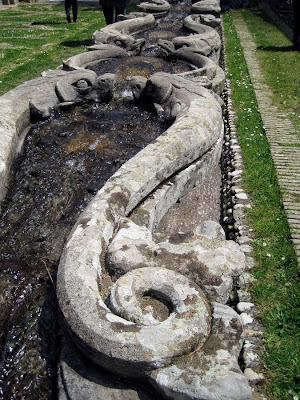
The duomo of Padua, S'Antonio, nicknamed simply the Santo.


Breathtaking Gothic architecture inside the Santo.

The high altar contains several sculptures by Donatello, but unfortunately, unless you are a nun, you can't get up close to them :/

The high altar itself.

Outside is a bronze equestrian monument to the mercenary Gattamalata by Donatello. It was the first large bronze equestrian monument since antiquity. Notice how the front leg of the horse rests on a canon ball? This is because artists of the time had yet to perfect the necessary interior supports.

Apparently the Paduan tradition for college graduates involves a poster describing some of your most embarrassing college moments...

...and public humiliation while being forced to read from that poster, drink, and be covered in slime. It was really fun to watch for a bit, and the whole town gets involved, young and old alike.

Frescoes by Mantegna inside the church of the Eremitani. The church was partially destroyed by allied bombing in WWII, and so these frescoes are in a sad state.

Some pictures of the church after the bombing.


The gray areas mark where the walls were completely destroyed.

The lighter colored areas show where parts of the wall survived, but without fresco.

And the little pieces show surviving frescoes. There really isn't anything left at all, but the reconstruction is really well done.

A detail of the fresco. Hate it when that happens!

One of the major sites in Padua is the Arena Chapel, decorated by Giotto in 1305. Giotto is often called the father or alternately the grandfather of the Renaissance, largely because of the frescoes in this chapel that usher in a new style of art dramatically different than that of the Middle Ages.

There are no pictures allowed inside, so these are from the web. The chapel is quite small and every single surface is covered in fresco. It's absolutely amazing. Given the age and condition of the frescoes you first have to sit in a purifying chamber for 15 minutes, and then are only allowed inside the chapel itself in groups of no more than 20 people for 15 minutes.

The main narratives are from the lives of Joachim and Anna (Mary's parents), Mary, and Christ. This is a scene with Joachim and some shepherds that I absolutely love because of the little sheep that look like bubbles.

I also love the camels in this scene of the nativity. Giotto painted everything so sweetly.

This is the scene we teach in our survey classes because it is a great example of Giotto's revolutionary style. For example, the simple decision to make the sky blue rather than gold was extraordinary. Some other aspects include showing figures in intense grief, painting figures who face away from the viewer, and modelling the drapery with light and shadow so that it looks like there is an actual body underneath.

Back in Venice, walking back to Michael's apartment we came across some interesting activity.

Turns out they were filming scenes for a new movie starring Johnny Depp and Angelina Jolie right next to his apartment.

Filming...

More filming...

Even more filming. These pictures are all blurry because I had to sneak them, but you get the idea. Unfortunately we didn't see the big stars, but surely we were caught on film at some point and will soon be famous!
























































